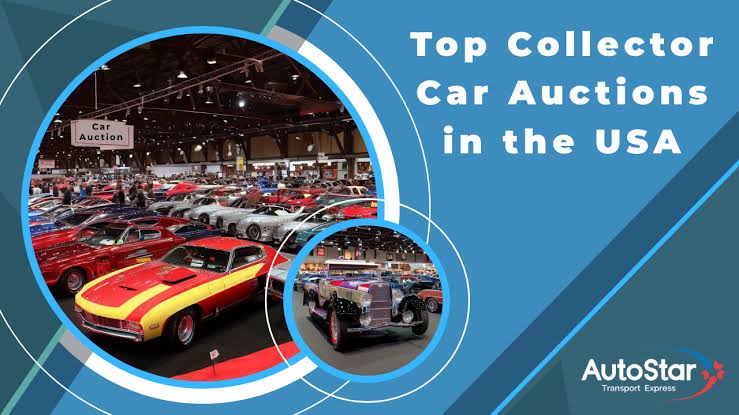When a 1962 Ferrari 250 GTO worth $48 million needs to travel from a private garage in Monaco to the Pebble Beach Concours d’Elegance, standard auto transport won’t work. A single scratch can cost hundreds of thousands in lost value.
“We handle vehicles where the insurance alone exceeds most people’s annual salary,” explains an operations manager at AutoStar Transport Express who has overseen the transport of some of the world’s most valuable collector cars. “Every detail matters when you’re moving automotive history.”
This guide reveals how the world’s most valuable automobiles move between collections, auction houses, and exhibitions.
The Collector Car Shipping Market
The collector car shipping industry has grown to $1.2 billion annually, driven by classic car auction sales exceeding $1.4 billion in 2023. Unlike standard auto transport, every vehicle receives museum-level care with zero tolerance for damage.
Barrett-Jackson, RM Sotheby’s, and Bonhams work exclusively with vetted transport specialists who provide specialized transport services for exotic autos. One damaged shipment can destroy decades of reputation in this industry.
Transportation Methods for Collector Vehicles
Enclosed Transport: Industry Standard
Enclosed transport protects collector cars with climate-controlled trailers featuring:
Climate Control: Maintains stable temperature and humidity to prevent condensation damage on original components.
Soft-Tie Systems: Padded restraints secure vehicles without touching paint or chrome surfaces.
Air Ride Suspension: Minimizes road shock that could damage delicate mechanical components.
Adjustable Decks: Multi-level loading accommodates everything from low Lamborghini Countachs to tall Ford GT40s.
Single-Car Transport: Maximum Protection
Vehicles worth $500,000+ often require dedicated trailers. Benefits include:
- Custom loading solutions for specific vehicles
- Direct routes with no additional stops
- Enhanced security with GPS tracking and monitoring
- Zero contact risk with other vehicles
“For a $2 million McLaren F1, the single-car premium pays for itself if it prevents even minor damage,” notes the AutoStar operations manager.
Air Freight: Emergency Transport
Reserved for million-dollar vehicles or critical auction deadlines. Requirements:
- Custom wooden crating meeting aviation standards
- Complete fluid drainage for safety compliance
- Pre-cleared customs documentation
- Specialized insurance coverage
Air freight costs $25,000-75,000 but delivers Europe to California in under 24 hours.
International Shipping Requirements
Cross-border collector car shipping involves complex documentation and regulations.
Essential Documentation
- Original titles with notarized translations
- Export permits (Italy restricts certain Ferrari exports)
- Import duty calculations
- EPA/DOT compliance verification for US imports
Shipping Methods
Container Shipping: Most common for international routes. Specialized containers with custom securing systems accommodate multiple vehicles while maintaining protection.
RoRo Services: Roll-on/roll-off shipping costs less but exposes vehicles to salt air and weather.
Air Freight: Premium option for highest-value shipments requiring immediate delivery.
Transport Equipment and Technology
Modern collector car shipping uses specialized equipment designed for high-value cargo.
Loading Systems
Hydraulic Lift Gates: Load extremely low cars without scraping expensive aerodynamic components. Some systems lift vehicles completely off the ground.
Wheel Cradle Systems: Support vehicles by wheels rather than suspension, preventing damage to modified or delicate suspension systems.
Soft Strapping: Advanced materials prevent wheel marks while providing secure attachment.
Security and Monitoring
- Real-time GPS tracking with route deviation alerts
- Environmental sensors monitoring temperature, humidity, and shock
- Interior cameras for remote cargo monitoring
- Multi-layer theft prevention systems
Collector Car Shipping Costs
Pricing reflects specialized equipment, training, and insurance requirements. Expect to pay $2-5 per mile versus $0.50-1.50 for standard transport.
Cost Breakdown
Regional Transport (Under 500 Miles):
- Standard enclosed: $1,200-2,500
- White-glove service: $2,000-4,000
- Single-car enclosed: $3,000-6,000
Cross-Country Transport:
- Standard enclosed: $3,500-7,500
- White-glove service: $6,000-12,000
- Single-car enclosed: $8,000-15,000
International Shipping:
- Europe to US container: $4,500-8,500
- Emergency air freight: $25,000-75,000
Insurance Requirements
Standard carrier insurance caps at $100,000-250,000, insufficient for collector vehicles. Options include:
- Declared value coverage up to $2-5 million (1-3% of declared value)
- Owner’s collector car insurance with transport coverage
- Specialized international marine/air cargo policies
“Most collectors underestimate insurance complexity until they need to file a claim,” warns the AutoStar operations manager. “Understanding coverage gaps before transport prevents expensive surprises.”
Documentation and Quality Control
Professional transport involves comprehensive documentation protecting both parties.
Pre-Transport Process
Digital Photography: 50-100+ images document existing condition, including close-ups of any damage, modifications, and unique features.
Condition Reports: Written documentation noting paint condition, interior wear, and mechanical status. Both customer and driver sign these reports.
Fluid and System Checks: Verification of all fluids, tire pressures, and battery condition ensures vehicles arrive mechanically unchanged.
Transport Monitoring
- GPS route adherence tracking
- Environmental condition monitoring
- Security system status updates
- Regular driver check-ins
Delivery Verification
Post-transport inspection compares vehicle condition to original documentation. Digital signatures confirm successful delivery and accelerate payment processing.
Selecting a Transport Service
Choose the best car shipping companies based on expertise, not just price. Key evaluation criteria:
Carrier Qualifications
Industry Experience: Verify specific collector car experience, not general auto transport.
Insurance Coverage: Confirm adequate coverage matching your vehicle’s value. Request insurance certificates.
Equipment Standards: Inspect trailers when possible. Quality carriers maintain newer equipment with proper climate control and security.
References: Check with other collectors, auction houses, and dealers. The collector community is small and reputation spreads quickly.
Service Standards
- Regular communication throughout transport
- Flexibility for special requirements
- Clear problem resolution policies
- Direct service coverage (not subcontracted)
“We see collectors make expensive mistakes by choosing the cheapest quote,” explains the AutoStar operations manager. “The cost difference between quality service and budget options disappears completely if anything goes wrong.”
Vehicle Preparation
Proper preparation reduces damage risk and ensures smooth transport.
Mechanical Preparation
- Maintain fuel levels between 1/4 and 1/2 tank
- Ensure battery is fully charged with clean terminals
- Adjust tires to manufacturer specifications
- Disable or adjust alarm systems to prevent false activation
Documentation
- Current registration accessible
- Insurance information available
- Written special handling instructions
- Multiple emergency contact methods
Physical Preparation
- Remove all personal items
- Secure or remove loose parts (antennas, spoilers)
- Clean vehicle for easier damage inspection
- Take personal photos for additional documentation
Common Transport Challenges
Ground Clearance Problems
Exotic cars often require special loading procedures:
- Hydraulic lift systems eliminate scraping risks
- Custom-angled ramps for extremely low vehicles
- Dollies and skates for ground-level lifting
Modified Vehicles
Wide-body kits and custom dimensions need accommodation:
- Precise measurement verification before transport
- Single-car solutions for oversized vehicles
- Custom securing methods for non-standard tie-down points
Seasonal Demand
Auction seasons create capacity and pricing pressures:
- Monterey, Scottsdale, and Amelia Island weeks see peak demand
- Book weeks or months ahead for popular routes
- Off-peak transport offers significant cost savings
“Planning ahead is crucial during auction season,” notes the AutoStar operations manager. “Last-minute bookings can cost double and may not be available at any price.”
Industry Evolution
Technology continues transforming collector car shipping:
IoT Monitoring: Real-time sensors detect problems before they cause damage Blockchain Documentation: Tamper-proof transport records valuable for authenticity verification Route Optimization: AI systems improve efficiency while maintaining service quality
Market Expansion: Growing collector markets in Asia and Middle East drive international shipping demand. Electric transport equipment and carbon offset programs address environmental concerns.
Conclusion
Collector car shipping protects automotive investments worth millions while enabling the global collector car market. Success requires understanding specialized requirements, selecting qualified carriers, and proper preparation.
The investment in professional collector car shipping preserves vehicle value and provides peace of mind. As the collector market grows, transport services evolve with new technology and expanded global reach.
Whether moving a Ferrari to auction or a classic to concours, professional transport ensures these automotive treasures reach their destinations safely. The specialized expertise, equipment, and procedures that define collector car shipping represent the difference between successful delivery and costly disaster.
FAQs
1. Why do collectors use enclosed transport for exotic cars instead of open carriers?
Enclosed transport provides maximum protection against weather, road debris, and theft. Specialized features like climate control, air ride suspension, and soft-tie systems ensure that rare vehicles are moved without damage.
2. How much does it cost to ship a high-value collector car?
Costs range from $2–5 per mile for domestic enclosed transport, with regional trips starting around $1,200–6,000 depending on service level. International container shipping costs $4,500–8,500, while emergency air freight ranges from $25,000–75,000.
3. What insurance coverage is required for transporting exotic cars?
Standard carrier insurance usually caps at $100,000–250,000, which is insufficient for multimillion-dollar vehicles. Collectors typically purchase declared value coverage up to several million dollars or rely on specialized transport/marine insurance policies.
4. What preparations should owners make before shipping a collector car?
Owners should:
- Keep fuel at 1/4–1/2 tank
- Fully charge the battery
- Adjust tire pressure
- Remove personal items and loose parts
- Clean the car for inspection
- Document condition with photos and reports
5. How do international shipments of collector cars work?
Collectors need original titles, export permits, customs clearance, and EPA/DOT compliance for U.S. imports. Cars are typically shipped in specialized containers, though air freight is used for urgent or high-value moves.

